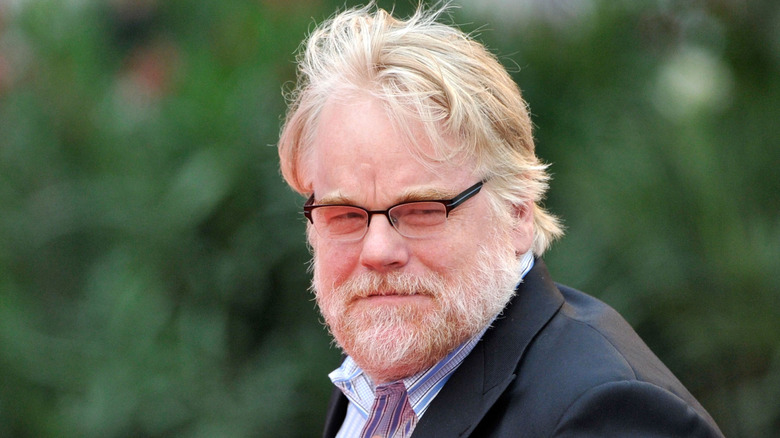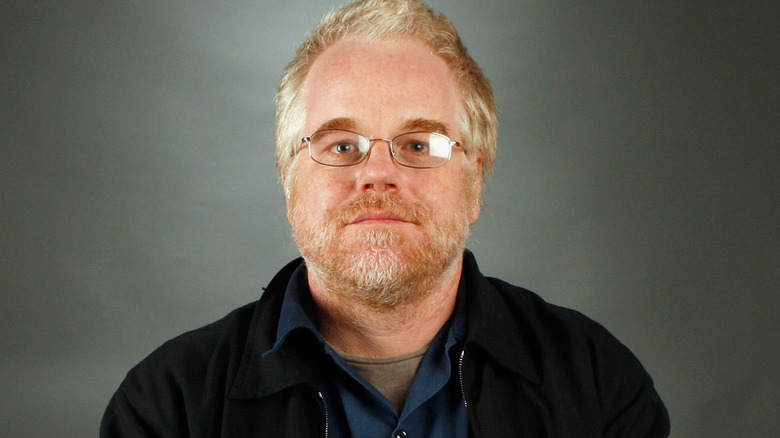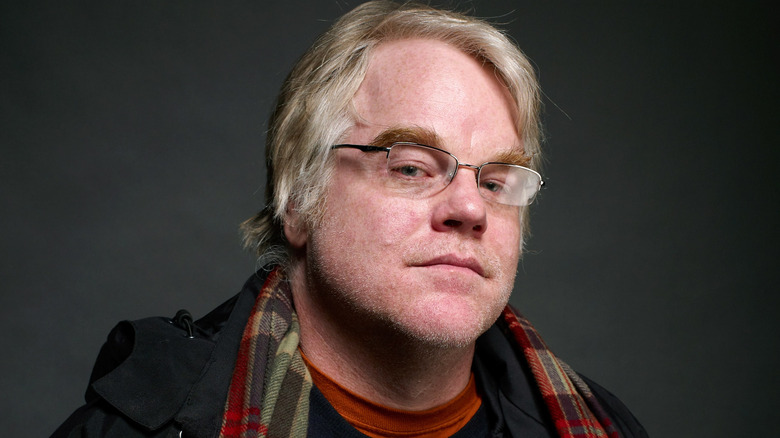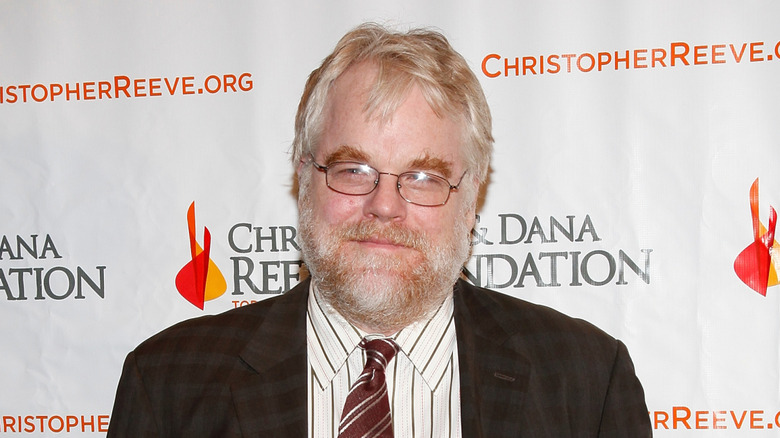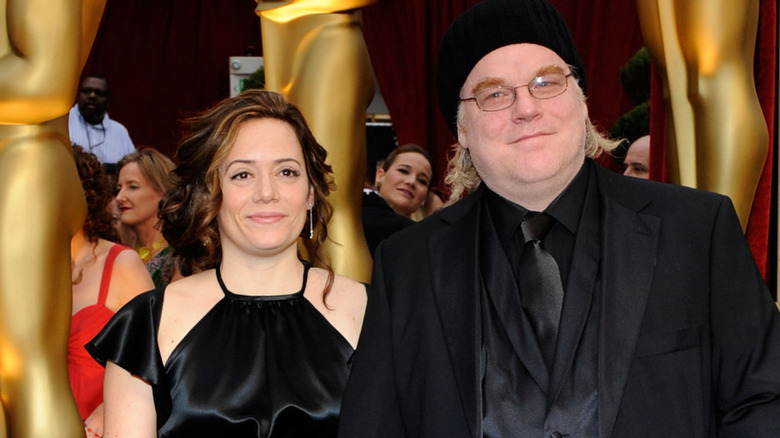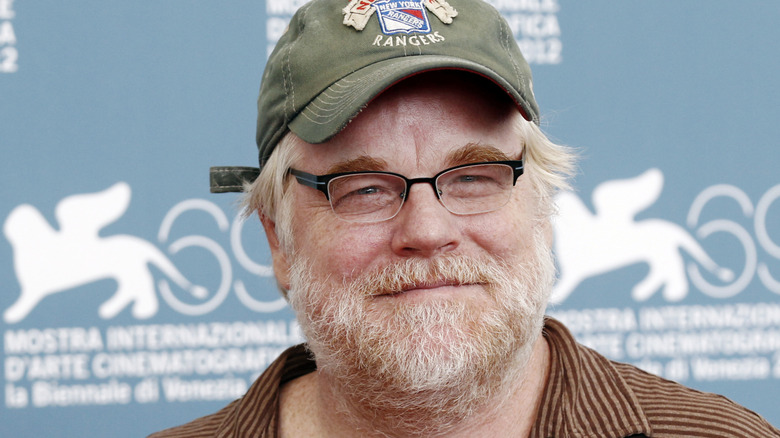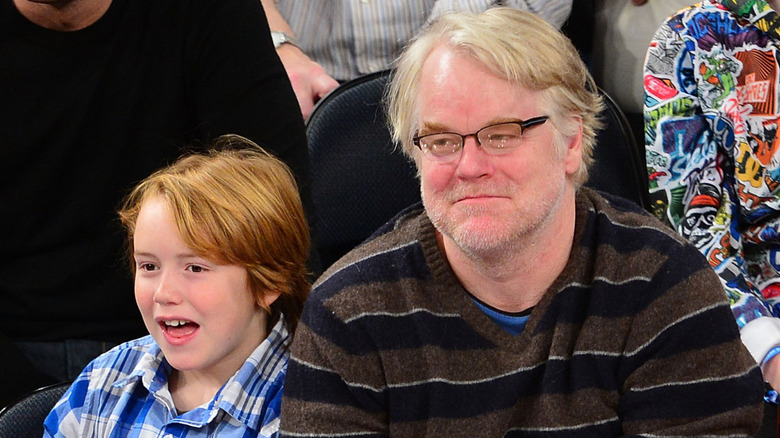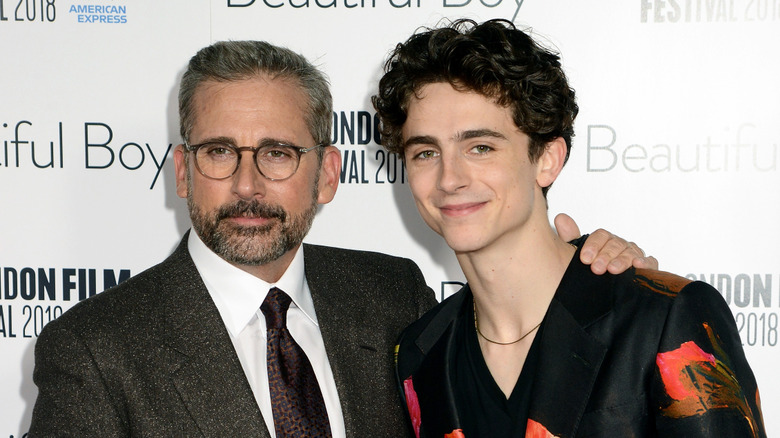What The Final Year Of Philip Seymour Hoffman's Life Was Like
Universally acclaimed and frequently awarded, Philip Seymour Hoffman succeeded in every avenue where he brought his formidable acting skills and talent. After paying his dues with minor roles in films and TV series in the 1990s, he emerged late in the decade as a solid actor who could lend seriousness to big, fun blockbusters like "Twister" and "Mission: Impossible III" as well as provide layers of emotional heft to the dozens of indie movies in which he appeared. A favorite of visionary directors, Hoffman often popped up in the ensemble casts of cult classics, like "The Big Lebowski," "The Talented Mr. Ripley," "Almost Famous," "Magnolia," "Punch-Drunk Love," and "The Savages." By the mid-2000s, Hoffman regularly found himself under awards consideration. Nominated for Academy Awards for "The Master," "Doubt," and "Charlie Wilson's War," Hoffman won the Best Actor prize for "Capote."
Apart from his nuanced, empathetic performances of all kinds of complicated characters, Hoffman quietly dealt with a lot of personal issues. It saddened and shocked the movie world in 2014 when Hoffman died at the age of 46, right at the peak of his acting fame. Throughout his last year alive and up until the very end, Hoffman kept busy with compelling projects and a rich personal life.
The following article mentions and describes issues surrounding addiction.
If you or anyone you know needs help with addiction issues, help is available. Visit the Substance Abuse and Mental Health Services Administration website or contact SAMHSA's National Helpline at 1-800-662-HELP (4357).
Hoffman made the awards show rounds for The Master
In September 2012, writer-director Paul Thomas Anderson released "The Master," his fifth and final collaboration with actor Philip Seymour Hoffman. The critically acclaimed drama starred Hoffman as Lancaster Dodd, the charming, paternal, and inscrutable leader of the Cause, a suspect religious movement turned cult. Still playing in movie theaters well into February 2013, "The Master" earned accolades on the film awards circuit, particularly for Hoffman's performance.
The actor was nominated in the supporting actor category by every major body, including the Academy Awards, the BAFTA Awards, the Critics Choice Awards, the Satellite Awards, the Screen Actors Guild Awards, and the Golden Globes. Hoffman was in attendance for most of the big and televised celebrations, taking home the trophy only at the Critics Choice Awards. He did, however, earn the top prize for supporting actor from multiple film critics associations, including the Chicago Film Critics Association, the Florida Film Critics Circle, the Kansas City Film Critics Circle, and the London Critics Circle.
He went to rehab
The specter of addiction shadowed Philip Seymour Hoffman for the entirety of his adult life. In his 20s, he drank heavily and dabbled in heroin, and he went to rehab at the age of 22. He remained in therapy and attended Alcoholics Anonymous meetings for many years after. "Being sober and a recovering addict was, along with acting and directing, very much the focus of his life," Hoffman's wife, Mimi O'Donnell, told Vogue in 2017. "But he was aware that just because he was clean didn't mean the addiction had gone away."
Hoffman maintained sobriety and lived a drug-free lifestyle for 23 years. Sometime in early 2012, he relapsed and found himself with a growing dependency upon powerful prescription medication. Over the course of the next year, Hoffman's addiction to pills segued into an addiction to heroin, which Hoffman said he snorted into his nose. Realizing that his lengthy break from sobriety was becoming unmanageable, Hoffman admitted himself to a drug detox and rehabilitation center, located somewhere in the eastern United States, in early May 2013.
Ten days later, with a pronounced clean bill of health, Hoffman was allowed to depart the facility and immediately flew to Europe to head to the set of a movie, in which he'd previously been contracted to appear.
Hoffman made and celebrated several independent films
As the Cannes Film Festival began in May 2013, producers of the film "God's Pocket" announced that filming was about to begin on an adaptation of the Pete Dexter novel about a working-class community, where a man tries to conceal the accidental death of his stepson. Philip Seymour Hoffman headlined the cast as Mickey Scarpato. "God's Pocket" filmed in Yonkers and Port Chester, New York, throughout 2013, and it hit theaters in 2014 following a debut at the Sundance Film Festival, which Hoffman attended to talk up the movie. "I got to work with some people I really admire greatly," the actor told Flicks and the City during the event.
Hoffman took on double publicity duties at the 2014 Sundance Film Festival, also showing up in support of another movie he'd filmed previously, "A Most Wanted Man." In that spy drama, which explores the turbulent relationship between Chechnya and Russia, Hoffman played a Chechen refugee and anti-terrorism agent on the run from Russian spies who escapes to Germany.
He returned to the New York theater scene
Before he became a star of the screen, Philip Seymour Hoffman was a prolific theater artist. In the early 1990s, he helped found the small, off-Broadway collective, the LAByrinth Theater Company. He directed, produced, and starred in some of its earliest and most well-attended productions, as well as eventually serving as the company's artistic director. Hoffman left that position in 2009, succeeded in part by his wife, costume designer Mimi O'Donnell, but he'd return to LAByrinth in 2013.
After a very high-profile starring turn on Broadway, as Willy Loman in a revival of Arthur Miller's "Death of a Salesman," for which he received a Tony Award nomination, Hoffman scaled back and rolled that success into a directing gig. He went back to LAByrinth Theater Company to direct a production of the play "A Family for All Occasions" at the Bank Street Theater in New York City. Composed by his friend, playwright Bob Glaudini, the production consumed Hoffman's energy. "From the napkin holder on the dining room table, every minute detail was debated and thought out," LAByrinth managing director Danny Feldman told Rolling Stone. "Even after opening night, he said, 'We're still working — we're still in rehearsal.'" The last major theatrical work of Hoffman's life and career, it played for the month of May 2013.
He dropped out of a movie
In June 2013, production got underway on the dark period thriller "Child 44." A film adaptation of Tom Rob Smith's hit novel (and potential trilogy starter) of the same name, it concerned a military police officer in post-World War II Soviet Union, set up by the infamously evil Joseph Stalin, tracking down a serial killer who targets children. The movie had already begun filming when Philip Seymour Hoffman joined the cast, which also included Tom Hardy and Gary Oldman, in the significant role of Major Kuzmin, making "Child 44" the first project he took on after his Academy Award nomination for "The Master."
Two months into filming, Hoffman abruptly dropped out of "Child 44." Neither the producers nor studio Summit Entertainment disclosed to the public why the actor abandoned the film, which quickly resumed filming with France-based actor Vincent Cassel stepping in to play the role vacated by Hoffman. Ultimately released in 2015 – more than a year after the death of Hoffman and bearing no trace of his presence — "Child 44" was a box office flop, earning just $1.2 million in a four-week theatrical run.
Hoffman joined the cast of The Hunger Games
Back in 2012, Philip Seymour Hoffman joined the expanding film franchise of "The Hunger Games." He signed up to portray Plutarch Heavensbee, designer of the arenas used to stage deadly competitions in a dystopian future America, in the second movie in the series, "Catching Fire." Over the next two years, Hoffman was locked down to the blockbuster saga, continuing to play the games-maker after he figures prominently in government affairs following a Hunger Games-staged rebellion and revolution. Working from "Mockingjay," the final entry in Suzanne Collins' trilogy of novels, filmmakers opted to produce two full-length movies, rounding out the various dumb things about "The Hunger Games" that most people ignored.
"Mockingjay – Part 1" arrived in theaters in November 2014, nine months after Hoffman died. Off and on throughout 2012 and in 2013, he'd spent many weeks on the set and filming his scenes. Hoffman had completed his work on "Mockingjay – Part I," but when the actor died during filming, he hadn't yet shot two dialogue-heavy scenes. Director Francis Lawrence set forth a rewrite of the script for those portions, giving out lines intended for Hoffman's character to other actors.
His marriage was in trouble
In the early 2010s and with the arrival of his 40s, Philip Seymour Hoffman fell into something of a mid-life crisis, according to his wife, Mimi O'Donnell. That anxiety led to a sobriety break, as did the traumatic death of Hoffman's therapist of many years. Hoffman obtained prescription painkillers, but didn't use them at first after his wife expressed concern. However, during a 2012 period in which he didn't have many work engagements, he became addicted to drugs.
Hoffman tried to quit without assistance, but it was so agonizing that O'Donnell checked Hoffman into a rehab center in early 2013. Within 48 hours of his release, he began using again. His behavior at home grew so unsteady that his three children expressed distress and unease, leading O'Donnell to ask Hoffman to move out. He found an apartment located near the family's, and O'Donnell prepared to end the marriage.
The independence gave Hoffman more opportunities to misuse heroin, and in the fall of 2013, his addiction progressed to the point where he needed another three months in rehab. He had to return to Atlanta to shoot the "Mockingjay" movies in early 2014, and O'Donnell helped him arrange another rehab stint for when he returned home. That wouldn't come to pass, as three days after he came back to New York, Hoffman died of a drug overdose.
Hoffman was supposed to get Happyish
The vast majority of Philip Seymour Hoffman's acting output was in film and theater. In January 2014, about eight years after he won an Academy Award for Best Actor for "Capote," a film about a famous yet strange author, Hoffman elected to join the emerging world of prestige television. Showtime ordered a dark comedy series by author Shalom Auslander called "Happyish." Hoffman was set to play the main character on the show: Thom Payne, an advertising executive man approaching middle age who experiences dissatisfaction and depression as he examines his comfortable existence, and finds it lacking. It would have been Hoffman's first role on a recurring, narrative series, and "Happyish" was a foundational show in a drive by Showtime to compete in the increasingly high-quality cable landscape. The network only agreed to make and air the show after Hoffman's involvement was secured.
Most of the first season's scripts for "Happyish" had been completed, though filming had yet to begin, when Hoffman died in February 2014, just two weeks after Showtime announced that the series was on the way. Production was delayed for most of a year so it could be recast, with Steve Coogan taking the role originally meant for Hoffman.
Hoffman was about ready to direct a movie
Philip Seymour Hoffman directed many stage plays, but in his expansive career he helmed just one movie: the 2010 indie romantic drama "Jack Goes Boating." In 2013, Hoffman quietly put in motion his follow-up film directorial effort. Screenwriter Keith Bunin's script for a 1920s-set rural supernatural thriller, "Ezekiel Moss," had been knocking around Hollywood for a couple of years before Hoffman discovered it and took a passionate interest. He worked closely with Bunin on rewrites and pre-production, after lining up production companies, Hoffman decided he wanted to direct the movie.
On January 31, 2014, A-list actors Jake Gyllenhaal and Amy Adams were announced as the signed co-leads of "Ezekiel Moss." Two days later, Hoffman died, which put the film into limbo for nearly a decade. Filmmaker James Gray took on the project in 2023, and as of 2025, Hoffman's ill-fated second shot at movie directing has yet to begin production.
He spent a lot of time enjoying time spent with his family and in New York City
While Philip Seymour Hoffman was professionally reclusive — he rarely agreed to sit for interviews — he didn't hide from the public. He was a common presence in Greenwich Village, where he lived with and then later close by his wife and three children. Hoffman enjoyed spending as much time as possible with his family when he wasn't shooting a movie on location, and was seen walking with his kids, going to restaurants, or hanging out together in quiet bars. Most Saturdays, Hoffman could be found at the athletic club Chelsea Piers, dutifully observing son Cooper's basketball practices. "He seemed great. He was just a regular guy, which is what I've always loved about him," photographer Victoria Will, who took some of the last photos of Hoffman, told People.
Hoffman's moments of public intoxication were also observed and noted. He frequented a restaurant called Oliver's with son Cooper, and after hanging out for hours, he'd return to silently and solitarily drink into the night. One resident saw him struggling to navigate the streets, and he had to be helped into his apartment building due to his high level of intoxication.
On the evening of February 1, 2014, Hoffman went out to dinner with some friends at a local place called Automatic Slim's. He stuck to a cranberry soda rather than beer, but later withdrew $1,200 from an ATM near his home in six separate transactions, while flanked by two unidentified adult males.
Philip Seymour Hoffman died in February 2014
On the morning of February 2, 2014, Philip Seymour Hoffman was supposed to go see his three young children at the apartment in the Greenwich Village neighborhood of New York City, where they lived with their mother Mimi O'Donnell. He didn't turn up as planned, and a concerned O'Donnell started calling on friends and associates to check in on her estranged husband, who had been living alone in an apartment two blocks away from that of the family. Hoffman's personal assistant went to the residence and entered, and inside she found the actor. He was in the bathroom, unresponsive and deceased, with a syringe used to inject heroin still present in his arm.
In the initial investigation into the scene of the death of the 46-year-old actor, police uncovered 49 small bags of heroin; 23 containers containing traces of heroin, indicating the drugs inside had been used; four bags full of what was presumably cocaine, and several prescription drugs. Hoffman's body was subjected to an autopsy, and in late February 2014, the New York City Medical Examiner's office delivered its report. Testing indicated that Hoffman died from a fatal combination of drugs on which he accidentally overdosed: cocaine, heroin, amphetamines, and prescription anti-anxiety medications.
His death helped inspire a film about addiction
Philip Seymour Hoffman's history with substance misuse and his attempts at sobriety were well known to the public before his drug-related death in February 2014. The actor's death, and the particular nature of it, inspired a writer who had also coped with addiction to make a movie on the subject. Author Luke Davies published "Candy: A Novel of Love and Addiction" and adapted the book into the screenplay for the 2006 movie "Candy," pulling from his own experiences.
In 2014, Davies was under consideration to adapt two memoirs, each by a father and son and both about the son's drug abuse, into one script called "Beautiful Boy." Initially, he didn't want the job because he didn't want to revisit the themes of "Candy" that soon. "Then Philip Seymour Hoffman died, and my father wrote me an email mentioning it, and saying, 'Luke, there are times when this family feels very blessed,'" Davies recalled to the Los Angeles Times. "He was talking, obliquely, about my own history with addiction. The email shifted everything for me." Struck by the loss of Hoffman to drugs and wanting to explore a father-son relationship, he agreed to write "Beautiful Boy," which was released in 2018 and starred Steve Carell and Timothée Chalamet.
